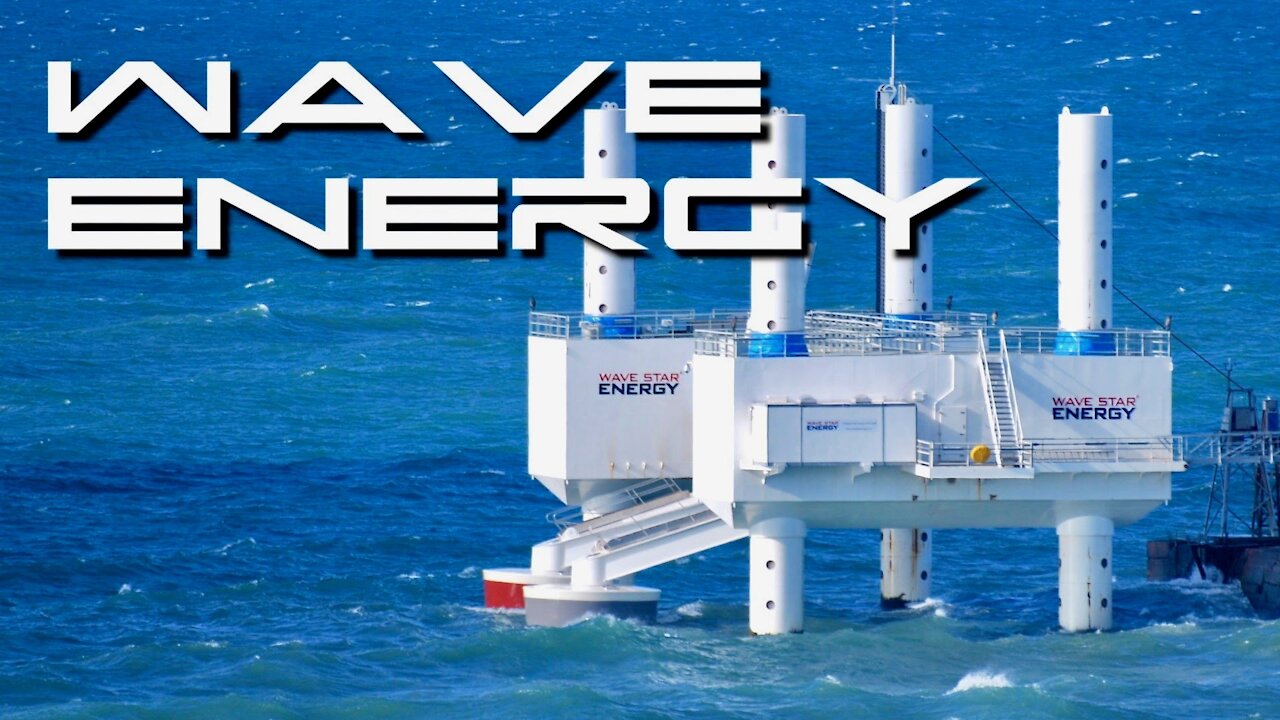Premium Only Content

Many Ways To Make Electricity From Ocean Kinetic Wave Energy - Zero Emissions
Wave power is the transport of energy by wind waves, and the capture of that energy to do useful work – for example, electricity generation, water desalination, or the pumping of water (into reservoirs). A machine able to exploit wave power is generally known as a wave energy converter (WEC). Wave power is distinct from the diurnal flux of tidal power and the steady gyre of ocean currents. Wave-power generation is not currently a widely employed commercial technology, although there have been attempts to use it since at least 1890. In 2008, the first experimental wave farm was opened in Portugal, at the Aguçadoura Wave Park
Physical concepts
Waves are generated by wind passing over the surface of the sea. As long as the waves propagate slower than the wind speed just above the waves, there is an energy transfer from the wind to the waves. Both air pressure differences between the upwind and the lee side of a wave crest, as well as friction on the water surface by the wind, making the water to go into the shear stress causes the growth of the waves.
Wave height is determined by wind speed, the duration of time the wind has been blowing, fetch (the distance over which the wind excites the waves) and by the depth and topography of the seafloor (which can focus or disperse the energy of the waves). A given wind speed has a matching practical limit over which time or distance will not produce larger waves. When this limit has been reached the sea is said to be "fully developed".
In general, larger waves are more powerful but wave power is also determined by wave speed, wavelength, and water density.
Oscillatory motion is highest at the surface and diminishes exponentially with depth. However, for standing waves (clapotis) near a reflecting coast, wave energy is also present as pressure oscillations at great depth, producing microseisms. These pressure fluctuations at greater depth are too small to be interesting from the point of view of wave power.
The waves propagate on the ocean surface, and the wave energy is also transported horizontally with the group velocity. The mean transport rate of the wave energy through a vertical plane of unit width, parallel to a wave crest, is called the wave energy flux (or wave power, which must not be confused with the actual power generated by a wave power device).
Wave power formula
In deep water where the water depth is larger than half the wavelength, the wave energy flux is[a]
P = \frac{\rho g^2}{64\pi} H_{m0}^2 T_e \approx \left(0.5 \frac{\text{kW}}{\text{m}^3 \cdot \text{s}} \right) H_{m0}^2\; T_e,
with P the wave energy flux per unit of wave-crest length, Hm0 the significant wave height, Te the wave energy period, ρ the water density and g the acceleration by gravity. The above formula states that wave power is proportional to the wave energy period and to the square of the wave height. When the significant wave height is given in metres, and the wave period in seconds, the result is the wave power in kilowatts (kW) per metre of wavefront length.[5][6][7][8]
Example: Consider moderate ocean swells, in deep water, a few km off a coastline, with a wave height of 3 m and a wave energy period of 8 seconds. Using the formula to solve for power, we get
P \approx 0.5 \frac{\text{kW}}{\text{m}^3 \cdot \text{s}} (3 \cdot \text{m}^2) (8 \cdot \text{s}) \approx 12 \frac{\text{kW}}{\text{m}},
meaning there are 36 kilowatts of power potential per meter of wave crest.
In major storms, the largest waves offshore are about 15 meters high and have a period of about 15 seconds. According to the above formula, such waves carry about 1.7 MW of power across each metre of wavefront.
An effective wave power device captures as much as possible of the wave energy flux. As a result, the waves will be of lower height in the region behind the wave power device.
Music: Orgasmic Dynamic by Dhruva Aliman
Amazon - https://amzn.to/3ex2DEb
https://music.apple.com/us/artist/dhruva-aliman/363563637
https://dhruvaaliman.bandcamp.com/album/neptunes-overtone
http://www.dhruvaaliman.com/
Spotify - https://open.spotify.com/artist/5XiFCr9iBKE6Cupltgnlet
#environment
#greenenergy
#sustainable
-
 52:31
52:31
Seeker Land
13 days agoMystery of the 3,000 Year Old Girl from Egtved Denmark - Life in the Bronze Age
153 -
 0:35
0:35
The Post Millennial Live
3 years agoBiden: "...by 2020, make sure all our electricity is zero emissions."
2757 -
 2:36
2:36
Reuters Innovation
3 years agoEnergy from bogs: using peat to make batteries
36 -
 1:00:36
1:00:36
Talk Nerdy 2 Us
5 hours agoDigital Surveillance, TikTok Shutdowns & The Hackers They Don’t Want You to Know About!
28.8K1 -
 3:08:37
3:08:37
SpartakusLIVE
8 hours agoDelta Force || Tactical, Strategic, HARDCORE
42.5K2 -
 3:32:05
3:32:05
I_Came_With_Fire_Podcast
12 hours agoTRUMP GUILTY Verdict, LA Fires, New American EXPANSIONISM, and Cyber Truck Updates!!
18K8 -
 1:26:05
1:26:05
Glenn Greenwald
8 hours agoGOP Senators Demand Tulsi Support Domestic Surveillance To Be Confirmed; Group Tracks IDF War Criminals Around The World; System Pupdate: Pointer's Determination To Survive | SYSTEM UPDATE #387
91.7K60 -
 57:27
57:27
Flyover Conservatives
1 day agoHealthy People Are Ungovernable: The Secrets They Don’t Want YOU to Know - Tracy Beanz | FOC Show
44.1K4 -
 8:36:11
8:36:11
Dr Disrespect
15 hours ago🔴LIVE - DR DISRESPECT - DELTA FORCE - INTENSE SITUATIONS ONLY!
241K27 -
 4:01:30
4:01:30
Nerdrotic
11 hours ago $33.42 earnedHollywood National DISASTER! Studios Terrified, Star Wars FAIL | Friday Night Tights 336 w Raz0rfist
139K43